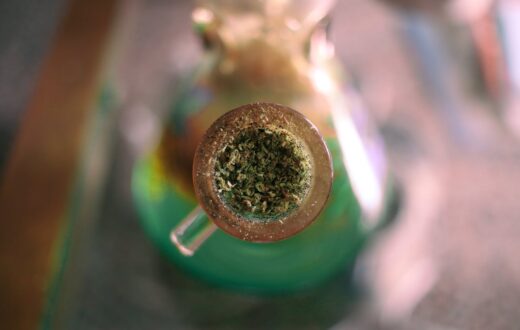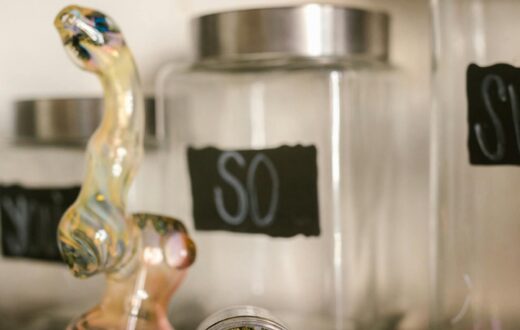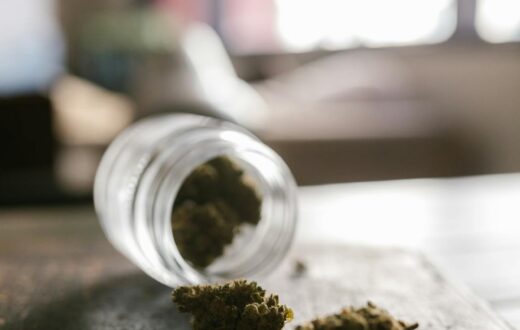Introduction to Caramel Cream Autoflower
Caramel Cream Autoflower is a distinctive cannabis strain that has quickly gained popularity among enthusiasts and growers alike. Originating from a carefully crafted lineage that merges the rich flavors of its parent strains, this autoflowering variant offers a combination of convenience and quality that appeals to both novice and experienced cultivators. The genetic makeup of Caramel Cream Autoflower includes a harmonious blend of Sweet Indica and Sativa characteristics, enabling a balanced profile that caters to various user preferences.
One of the most remarkable traits of Caramel Cream Autoflower is its unique flavor profile. The strain is well-known for its creamy, sweet taste with hints of caramel, drawing in those who appreciate a delightful smoking or vaping experience. This flavor is complemented by an equally enjoyable aroma, which features notes of vanilla and earthy undertones, making it a sensory delight. The effects are predominantly relaxing and uplifting, suitable for unwinding after a long day or sparking creativity during social gatherings.
The growth patterns of Caramel Cream Autoflower add to its allure; as an autoflowering strain, it has a shorter life cycle compared to photoperiod varieties. Typically, this strain can go from seed to harvest in approximately 8-10 weeks. This rapid growth and flowering time make it an attractive choice for those who may have limited time or space to cultivate cannabis. Additionally, Caramel Cream Autoflower boasts a robust structure and can thrive in diverse growing conditions, whether indoors or outdoors, requiring minimal maintenance and attention.
In summary, Caramel Cream Autoflower stands out as an excellent choice for individuals looking to cultivate cannabis with delightful flavors and potent effects. Its origins, flavor profile, and high adaptability make it a strain worth considering for growers of all levels.
Understanding Autoflowering Strains
Autoflowering strains represent a significant advancement in cannabis cultivation, distinguished primarily by their unique growth characteristics that set them apart from traditional photoperiod strains. Unlike photoperiod cannabis, which requires specific light cycles to trigger flowering, autoflowering strains transition automatically from the vegetative stage to the flowering stage based on age rather than light exposure. This inherent trait results from the incorporation of the Cannabis ruderalis gene, which enables these plants to adapt to their environments and thrive under various conditions.
The advantages of cultivating autoflowering strains are manifold, particularly for those seeking to optimize their growing experience. One prominent benefit is the remarkably shorter growth cycle. Most autoflowering varieties can go from seed to harvest in as little as eight to ten weeks, making them suitable for a multitude of growing environments, including those with time constraints or limited seasonal windows. This rapid maturation not only allows for multiple harvests within a single growing season but also provides a means to adjust cultivation strategies based on previous yields.
Moreover, the simplified nature of growing autoflowers appeals to beginners or those with limited space. Autoflowering plants typically require less meticulous monitoring in terms of light schedules, allowing cultivators to focus more on nurturing their plants rather than adhering to strict light cycles. This lack of dependency on photo-specific lighting lends itself to a more efficient use of space and resources, often leading to successful harvests with relatively minimal effort. When considering how to grow caramel cream autoflower or any other similar strain, it becomes evident that embracing autoflowering genetics can facilitate ease of cultivation while maximizing yield potential.
Ideal Growing Conditions for Caramel Cream Autoflower
To successfully cultivate Caramel Cream Autoflower, it is essential to understand the optimal environmental conditions that promote healthy growth and robust yields. This particular strain thrives in specific temperature, humidity, and light settings, which can significantly influence its development and overall quality.
The ideal temperature for growing Caramel Cream Autoflower ranges between 70°F to 85°F (20°C to 29°C). Maintaining this temperature range, especially during the daytime, encourages the plants to perform photosynthesis effectively. Nighttime temperatures should not fall below 60°F (15°C) to avoid any potential stress that can hinder growth. Temperature fluctuations outside this range can lead to stunted growth or reduced yield, highlighting the necessity of a controlled environment.
Humidity levels play a critical role as well. During the vegetative stage, a humidity level of 50% to 70% is optimal, promoting healthy leaf and root development. As the plant transitions into the flowering stage, it is advisable to lower the humidity to around 40% to 50%. This reduction helps prevent mold and mildew, which can be detrimental, especially in denser bud formations typical of this strain.
Light requirements are also crucial for the growth of Caramel Cream Autoflower. Providing 18 to 24 hours of light per day will optimize growth during the vegetative phase, while ensuring adequate light during flowering is equally important. Using full-spectrum LED or high-intensity discharge lights can be beneficial, as they mimic natural sunlight and provide the necessary spectrum for photosynthesis.
Finally, the choice of soil should not be overlooked. A well-draining potting mix that retains moisture yet allows for adequate aeration is preferable. The ideal soil pH level for Caramel Cream Autoflower should be between 6.0 and 7.0, promoting nutrient availability and uptake. Implementing these optimal growing conditions will enhance the potential for a successful and rewarding harvest.
Seed Selection and Germination Process
Choosing high-quality seeds is the foundation of a successful cultivation experience, particularly when it comes to growing Caramel Cream Autoflower strains. To begin your journey, it is crucial to source seeds from reputable breeders who have a demonstrated history of success. This not only ensures that you acquire seeds with desirable genetic traits but also minimizes the risk of disease or other growth impediments. Furthermore, examining customer reviews and gaining insights from fellow growers can guide you toward reliable seed banks or suppliers.
Once you have selected your seeds, the germination process is the next essential step in learning how to grow Caramel Cream Autoflower. Various methods exist to germinate seeds effectively, and it is important to choose one that aligns with your growing preferences. One popular technique involves the paper towel method. Begin by moisten a paper towel with distilled water, ensuring it is damp but not overly saturated. Place your seeds on one half of the towel and fold the other half over the seeds. Seal the towel in a plastic bag to create a humid environment, and place it in a warm location, typically around 70 to 80 degrees Fahrenheit.
After a few days, you should notice small taproots emerging from the seeds, indicating successful germination. At this stage, you can transfer the germinated seeds into a growing medium. Gentle handling is essential to avoid damaging the delicate taproots. Alternatively, you may choose to germinate the seeds directly in soil or a propagation tray filled with a light mixture designed for seedlings. Regardless of the method you choose, a consistent moisture level and appropriate temperature during germination will significantly increase the likelihood of success. By following these guidelines, you will be well on your way to successfully growing Caramel Cream Autoflower.
Nutrient Requirements and Feeding Schedule
Understanding the nutrient requirements for Caramel Cream Autoflower is essential for achieving a successful grow. These plants require a balanced mix of macronutrients and micronutrients throughout their life cycle, which includes the seedling, vegetative, and flowering stages. A well-crafted feeding schedule will ensure that your plants receive the necessary nutrients at the right times to promote healthy growth.
During the seedling stage, Caramel Cream Autoflower plants thrive on a light nutrient mix, primarily focusing on nitrogen, phosphorus, and potassium (NPK). Typically, a ratio of 1-2-1 is advisable to initiate strong growth while preventing nutrient burn. It’s crucial to monitor the seedlings closely, as they are particularly sensitive to excess nutrients. A feeding schedule that suggests watering with this diluted solution every ten days can effectively support their early development.
As your plants transition into the vegetative stage, the nutrient requirements shift. This stage calls for an increase in nitrogen, which is vital for leaf and stem development. A nutrient ratio of 2-1-2 can be beneficial. It is also important to continue feeding them every week, ensuring the nutrients are well diluted to reduce the risk of nutrient toxicity. Micronutrients such as calcium and magnesium should not be overlooked, as they play crucial roles in overall plant health and development.
Entering the flowering stage prompts a significant change in nutrient composition. This phase demands a shift towards a higher phosphorus and potassium ratio, commonly represented as 1-3-2. Nutrients in this ratio will support bud formation and enhance overall bloom quality. Regular feeding should continue, with careful monitoring for any signs of nutrient burn. Adjusting the pH of your nutrient solution can significantly help in maximizing nutrient absorption, ensuring optimal growth for your Caramel Cream Autoflower plants.
Training Techniques for Improved Yields
In the pursuit of maximizing yields for Caramel Cream Autoflower, employing effective training techniques is essential. Among the various methods available, Low Stress Training (LST) and topping are two of the most popular techniques used by growers. Both methods enhance light exposure and airflow to the plant, crucial elements for healthy growth and the development of abundant buds.
Low Stress Training involves gently bending and securing branches to encourage the plant to grow horizontally rather than vertically. This technique maximizes the number of colas receiving light, which can lead to a more uniform canopy. For Caramel Cream Autoflower, LST should be applied during the vegetative stage when the plants are still pliable. Early manipulation promotes the establishment of a stronger structure, enabling the plant to support the weight of future buds efficiently.
Topping is another method that involves trimming the main stem, promoting the growth of multiple main colas. By cutting off the top, the plant will redirect its energy to the remaining branches, leading to a bushier form and potentially higher yields. For Caramel Cream Autoflower, it is advisable to top the plant before it enters the flowering stage, ideally when there are six to eight nodes. Timing is critical, as it helps ensure that the plant has adequate time to recover and develop new growth before flowering begins.
When integrating these techniques, it’s crucial to monitor plant response closely. Growth rates can vary, and some Caramel Cream Autoflower strains may thrive better with one technique compared to the other. Therefore, performing these training techniques not only encourages larger yields but also allows growers to develop a deeper understanding of their plants’ specific needs.
Pest and Disease Management
Growing Caramel Cream Autoflower can be a rewarding experience, but it is crucial to be vigilant about potential pests and diseases that can threaten the health of your plants. Common pests that may affect your Caramel Cream Autoflower plants include aphids, spider mites, and whiteflies. These insects can weaken your plants by feeding on their sap, leading to stunted growth and reduced yield. To prevent infestations, ensure proper air circulation around your plants and maintain cleanliness in the growing area, as this can discourage pest habitation.
Additionally, regular inspections of your plants will help catch any early signs of pests or diseases. Look for discolored or wilting leaves, as these are often indications of underlying issues. The use of companion plants can also deter pests naturally; for instance, marigolds are known to repel various insects, making them a beneficial addition to your garden.
Diseases such as powdery mildew, root rot, and leaf blight can also affect Caramel Cream Autoflower plants. Powdery mildew often occurs in humid conditions and can be managed by ensuring adequate airflow and maintaining proper humidity levels. If you notice signs of this disease, an organic solution like a diluted mixture of water and baking soda can be effective.
For root rot, it is essential to avoid overwatering your plants and ensure that the grow medium provides proper drainage. If you detect root rot, removing affected roots may be necessary, and treating the remaining healthy roots with beneficial bacteria can help restore the plant’s health.
In cases where infestations or diseases are severe, chemical treatments may be necessary. Always follow the manufacturer’s instructions and consider the possible impact on your plants and the environment. By implementing these proactive measures, you can successfully manage pests and diseases and ensure your Caramel Cream Autoflower plants thrive.
Harvesting and Curing Your Crop
Growing Caramel Cream Autoflower can be an immensely rewarding experience, especially when it comes time to harvest. Recognizing the signs of maturity is crucial to ensuring optimal potency and flavor. Generally, the plant is ready to be harvested when approximately 70-80% of the pistils have turned from white to a rich amber or reddish hue. Additionally, the trichomes should appear cloudy with a few turning amber, indicating peak cannabinoid production. Observing these signs will help you determine the right moment to harvest your crop.
Once you have confirmed that your Caramel Cream Autoflower is ready for harvest, the next step is the actual cutting of the buds. Use sharp, clean scissors or pruning shears to cut the branches of the plant. It is advisable to harvest in the morning, as the resin will be most potent before the temperature rises. After cutting, it’s important to handle the buds carefully to avoid damaging their delicate structure.
Following the harvest, proper trimming is essential. Trim away the excess leaves surrounding the buds to enhance the visual appeal and maximize the drying process. After trimming, hang the branches upside down in a cool, dark, and well-ventilated area to dry for about 7-14 days. The ideal humidity levels during this stage should hover between 45-55% to prevent mold growth. Once the branches snap easily, signaling that the buds are sufficiently dry, it is time to proceed to the curing process.
Curing involves placing the dried buds into airtight containers, which should be opened daily for the first week to release moisture trapped inside. This process not only enhances the flavor profile of the Caramel Cream Autoflower but also ensures that the overall potency improves. Allowing your crop to cure for several weeks will yield a much more enjoyable and flavorful experience. Ultimately, paying careful attention to harvesting and curing techniques will allow you to reap the full benefits of your hard work.
Conclusion: Growing Caramel Cream Autoflower Successfully
In conclusion, successfully growing Caramel Cream Autoflower involves a combination of careful planning, proper cultivation techniques, and ongoing attentiveness to the plants’ needs. To begin with, selecting high-quality seeds from a reputable source is critical; this ensures that growers start off with strong genetics, which ultimately influences the yield and quality of the final product. By understanding the specific growth patterns of autoflowering strains, growers can effectively create optimal conditions for this particular variety, which will flourish under the right circumstances.
Moreover, it is essential to provide Caramel Cream Autoflower with a balanced nutrient regimen. The plants thrive in nutrient-rich soil, and careful monitoring of their feeding schedule will promote healthy growth throughout the plant’s lifecycle. Additionally, implementing appropriate light cycles plays a significant role in the successful cultivation of these autoflowering plants, as they do not depend on light duration for flowering but still appreciate consistent light exposure for maximum growth.
Another crucial aspect to consider is environmental factors, such as temperature and humidity. Maintaining the right conditions will not only enhance growth but also help in preventing pests and diseases. Regularly checking on your plants and making necessary adjustments based on their growth stage can significantly impact overall success.
Finally, engaging with fellow growers through forums or social media can enrich your own knowledge and support your growth journey. Sharing experiences and tips enhances community ties and further aids in mastering how to grow Caramel Cream Autoflower. We encourage all growers to apply the practices discussed throughout this blog post and share their insights, cultivating a supportive community dedicated to enhancing their growing endeavors.













